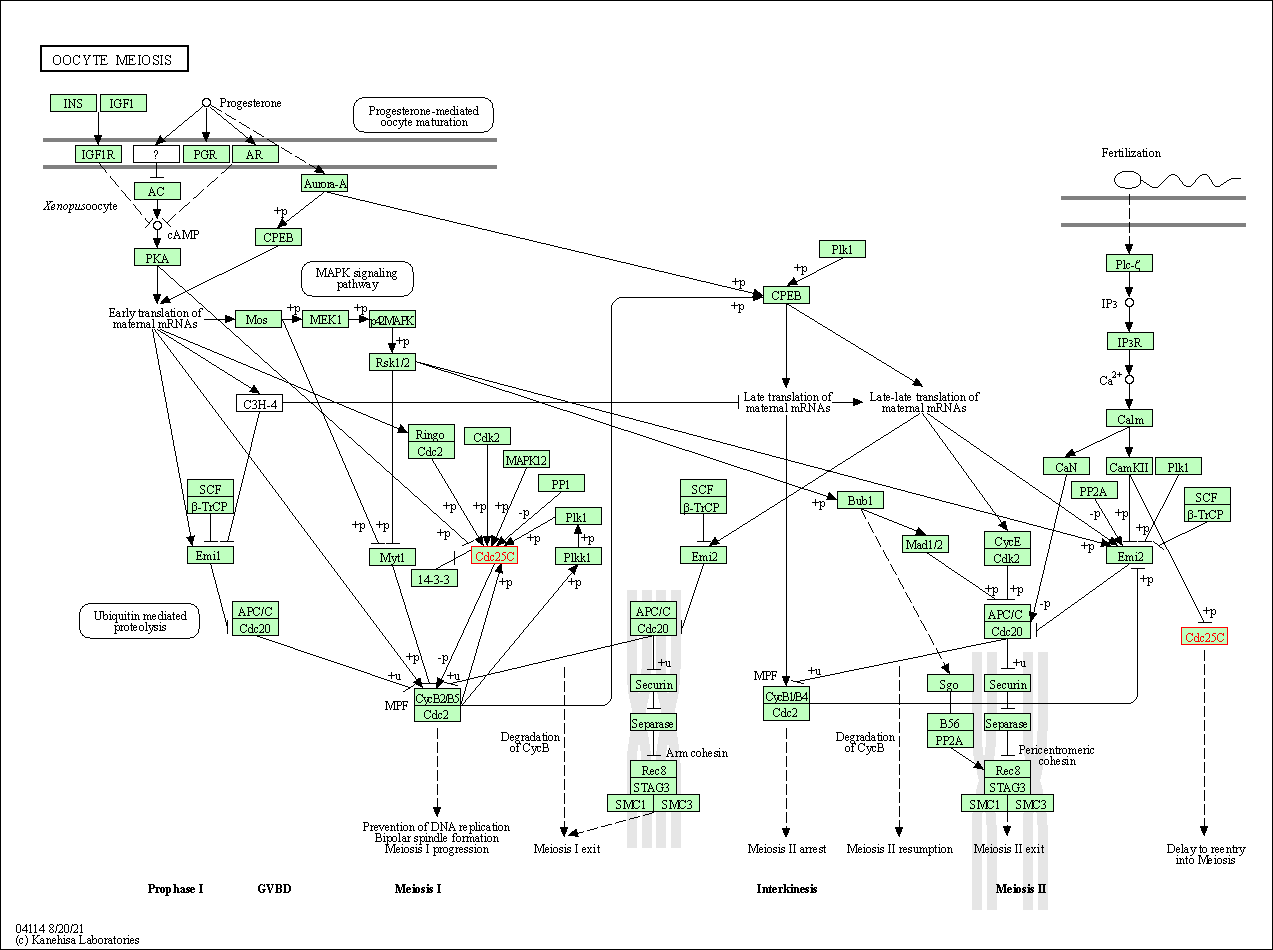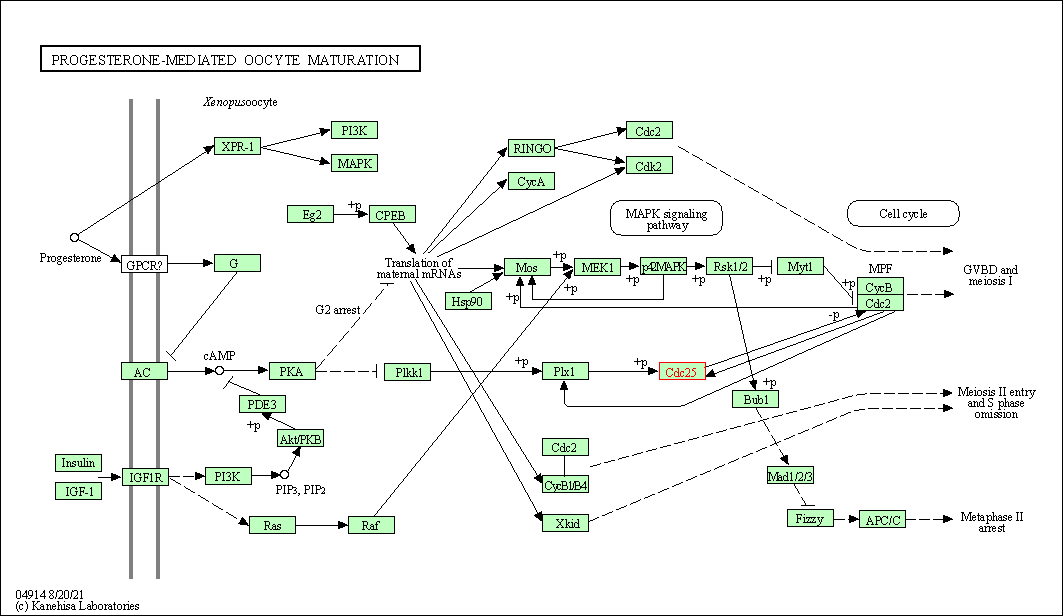Target Information
| Target General Information | Top | |||||
|---|---|---|---|---|---|---|
| Target ID |
T19011
(Former ID: TTDR00208)
|
|||||
| Target Name |
M-phase inducer phosphatase 3 (MPIP3)
|
|||||
| Synonyms |
Dual specificity phosphatase Cdc25C; Cdc25C phosphatase
Click to Show/Hide
|
|||||
| Gene Name |
CDC25C
|
|||||
| Target Type |
Literature-reported target
|
[1] | ||||
| Disease | [+] 1 Target-related Diseases | + | ||||
| 1 | Solid tumour/cancer [ICD-11: 2A00-2F9Z] | |||||
| Function |
Tyrosine protein phosphatase required for progression of the cell cycle. When phosphorylated, highly effective in activating G2 cells into prophase. Directly dephosphorylates CDK1 and activates its kinase activity. Functions as a dosage-dependent inducer in mitotic control.
Click to Show/Hide
|
|||||
| BioChemical Class |
Phosphoric monoester hydrolase
|
|||||
| UniProt ID | ||||||
| EC Number |
EC 3.1.3.48
|
|||||
| Sequence |
MSTELFSSTREEGSSGSGPSFRSNQRKMLNLLLERDTSFTVCPDVPRTPVGKFLGDSANL
SILSGGTPKRCLDLSNLSSGEITATQLTTSADLDETGHLDSSGLQEVHLAGMNHDQHLMK CSPAQLLCSTPNGLDRGHRKRDAMCSSSANKENDNGNLVDSEMKYLGSPITTVPKLDKNP NLGEDQAEEISDELMEFSLKDQEAKVSRSGLYRSPSMPENLNRPRLKQVEKFKDNTIPDK VKKKYFSGQGKLRKGLCLKKTVSLCDITITQMLEEDSNQGHLIGDFSKVCALPTVSGKHQ DLKYVNPETVAALLSGKFQGLIEKFYVIDCRYPYEYLGGHIQGALNLYSQEELFNFFLKK PIVPLDTQKRIIIVFHCEFSSERGPRMCRCLREEDRSLNQYPALYYPELYILKGGYRDFF PEYMELCEPQSYCPMHHQDHKTELLRCRSQSKVQEGERQLREQIALLVKDMSP Click to Show/Hide
|
|||||
| 3D Structure | Click to Show 3D Structure of This Target | AlphaFold | ||||
| HIT2.0 ID | T42K6K | |||||
| Drugs and Modes of Action | Top | |||||
|---|---|---|---|---|---|---|
| Discontinued Drug(s) | [+] 1 Discontinued Drugs | + | ||||
| 1 | MX-7065 | Drug Info | Terminated | Solid tumour/cancer | [2] | |
| Mode of Action | [+] 1 Modes of Action | + | ||||
| Inhibitor | [+] 4 Inhibitor drugs | + | ||||
| 1 | MX-7065 | Drug Info | [1] | |||
| 2 | BN-82002 | Drug Info | [3] | |||
| 3 | BN-82685 | Drug Info | [4] | |||
| 4 | NSC-663284 | Drug Info | [4] | |||
| Cell-based Target Expression Variations | Top | |||||
|---|---|---|---|---|---|---|
| Cell-based Target Expression Variations | ||||||
| Drug Binding Sites of Target | Top | |||||
|---|---|---|---|---|---|---|
| Ligand Name: L-serine-O-phosphate | Ligand Info | |||||
| Structure Description | The molecular tweezer CLR01 stabilizes a disordered protein-protein interface | PDB:5M37 | ||||
| Method | X-ray diffraction | Resolution | 2.35 Å | Mutation | No | [5] |
| PDB Sequence |
SRSGLYRSPM
217 PENLNRP
|
|||||
|
|
||||||
| Click to View More Binding Site Information of This Target and Ligand Pair | ||||||
| Ligand Name: [(1S,5R,9R,16S,20S,24R,28R,35S)-22-phosphonooxy-3-tridecacyclo[22.14.1.15,20.19,16.128,35.02,23.04,21.06,19.08,17.010,15.025,38.027,36.029,34]dotetraconta-2,4(21),6(19),7,10,12,14,17,22,25(38),26,29,31,33,36-pentadecaenyl] dihydrogen phosphate | Ligand Info | |||||
| Structure Description | The molecular tweezer CLR01 stabilizes a disordered protein-protein interface | PDB:5M37 | ||||
| Method | X-ray diffraction | Resolution | 2.35 Å | Mutation | No | [5] |
| PDB Sequence |
SRSGLYRSPM
217 PENLNRP
|
|||||
|
|
||||||
| Click to View More Binding Site Information of This Target and Ligand Pair | ||||||
| Click to View More Binding Site Information of This Target with Different Ligands | ||||||
| Different Human System Profiles of Target | Top |
|---|---|
|
Human Similarity Proteins
of target is determined by comparing the sequence similarity of all human proteins with the target based on BLAST. The similarity proteins for a target are defined as the proteins with E-value < 0.005 and outside the protein families of the target.
A target that has fewer human similarity proteins outside its family is commonly regarded to possess a greater capacity to avoid undesired interactions and thus increase the possibility of finding successful drugs
(Brief Bioinform, 21: 649-662, 2020).
Human Pathway Affiliation
of target is determined by the life-essential pathways provided on KEGG database. The target-affiliated pathways were defined based on the following two criteria (a) the pathways of the studied target should be life-essential for both healthy individuals and patients, and (b) the studied target should occupy an upstream position in the pathways and therefore had the ability to regulate biological function.
Targets involved in a fewer pathways have greater likelihood to be successfully developed, while those associated with more human pathways increase the chance of undesirable interferences with other human processes
(Pharmacol Rev, 58: 259-279, 2006).
Biological Network Descriptors
of target is determined based on a human protein-protein interactions (PPI) network consisting of 9,309 proteins and 52,713 PPIs, which were with a high confidence score of ≥ 0.95 collected from STRING database.
The network properties of targets based on protein-protein interactions (PPIs) have been widely adopted for the assessment of target’s druggability. Proteins with high node degree tend to have a high impact on network function through multiple interactions, while proteins with high betweenness centrality are regarded to be central for communication in interaction networks and regulate the flow of signaling information
(Front Pharmacol, 9, 1245, 2018;
Curr Opin Struct Biol. 44:134-142, 2017).
Human Similarity Proteins
Human Pathway Affiliation
Biological Network Descriptors
|
|
|
There is no similarity protein (E value < 0.005) for this target
|



| KEGG Pathway | Pathway ID | Affiliated Target | Pathway Map |
|---|---|---|---|
| Cell cycle | hsa04110 | Affiliated Target |

|
| Class: Cellular Processes => Cell growth and death | Pathway Hierarchy | ||
| Oocyte meiosis | hsa04114 | Affiliated Target |

|
| Class: Cellular Processes => Cell growth and death | Pathway Hierarchy | ||
| Progesterone-mediated oocyte maturation | hsa04914 | Affiliated Target |

|
| Class: Organismal Systems => Endocrine system | Pathway Hierarchy | ||
| Degree | 18 | Degree centrality | 1.93E-03 | Betweenness centrality | 1.38E-04 |
|---|---|---|---|---|---|
| Closeness centrality | 2.40E-01 | Radiality | 1.42E+01 | Clustering coefficient | 3.79E-01 |
| Neighborhood connectivity | 6.00E+01 | Topological coefficient | 1.18E-01 | Eccentricity | 12 |
| Download | Click to Download the Full PPI Network of This Target | ||||
| Chemical Structure based Activity Landscape of Target | Top |
|---|---|
| Target Poor or Non Binders | Top | |||||
|---|---|---|---|---|---|---|
| Target Poor or Non Binders | ||||||
| Target Regulators | Top | |||||
|---|---|---|---|---|---|---|
| Target-regulating microRNAs | ||||||
| Target-regulating Transcription Factors | ||||||
| Target-interacting Proteins | ||||||
| Target Affiliated Biological Pathways | Top | |||||
|---|---|---|---|---|---|---|
| KEGG Pathway | [+] 4 KEGG Pathways | + | ||||
| 1 | Cell cycle | |||||
| 2 | Oocyte meiosis | |||||
| 3 | Progesterone-mediated oocyte maturation | |||||
| 4 | MicroRNAs in cancer | |||||
| Panther Pathway | [+] 1 Panther Pathways | + | ||||
| 1 | p53 pathway | |||||
| PID Pathway | [+] 4 PID Pathways | + | ||||
| 1 | ATR signaling pathway | |||||
| 2 | ATM pathway | |||||
| 3 | PLK1 signaling events | |||||
| 4 | PLK3 signaling events | |||||
| Reactome | [+] 6 Reactome Pathways | + | ||||
| 1 | Polo-like kinase mediated events | |||||
| 2 | Cyclin B2 mediated events | |||||
| 3 | Activation of ATR in response to replication stress | |||||
| 4 | RHO GTPases activate PKNs | |||||
| 5 | Cyclin A/B1 associated events during G2/M transition | |||||
| 6 | Chk1/Chk2(Cds1) mediated inactivation of Cyclin B:Cdk1 complex | |||||
| WikiPathways | [+] 8 WikiPathways | + | ||||
| 1 | Monoamine Transport | |||||
| 2 | DNA Damage Response | |||||
| 3 | ATM Signaling Pathway | |||||
| 4 | Integrated Pancreatic Cancer Pathway | |||||
| 5 | Mitotic G2-G2/M phases | |||||
| 6 | Cell Cycle | |||||
| 7 | Cell Cycle Checkpoints | |||||
| 8 | miRNA Regulation of DNA Damage Response | |||||
| Target-Related Models and Studies | Top | |||||
|---|---|---|---|---|---|---|
| Target Validation | ||||||
| References | Top | |||||
|---|---|---|---|---|---|---|
| REF 1 | Handbook of Assay Development in Drug Discovery, Lisa K. Minor, 2013. Page(11). | |||||
| REF 2 | Trusted, scientifically sound profiles of drug programs, clinical trials, safety reports, and company deals, written by scientists. Springer. 2015. Adis Insight (drug id 800016615) | |||||
| REF 3 | Synthesis of small molecule CDC25 phosphatases inhibitors. Bioorg Med Chem Lett. 2004 Dec 6;14(23):5809-12. | |||||
| REF 4 | Synthesis and biological evaluation of novel heterocyclic quinones as inhibitors of the dual specificity protein phosphatase CDC25C. Bioorg Med Chem Lett. 2006 Jan 1;16(1):171-5. | |||||
| REF 5 | The Molecular Tweezer CLR01 Stabilizes a Disordered Protein-Protein Interface. J Am Chem Soc. 2017 Nov 15;139(45):16256-16263. | |||||
If You Find Any Error in Data or Bug in Web Service, Please Kindly Report It to Dr. Zhou and Dr. Zhang.

